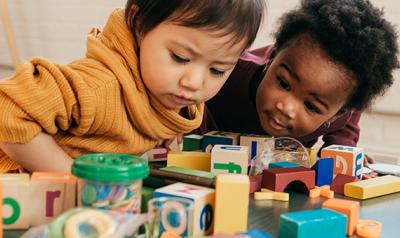Dedicate Time for Structured Play
When a child has time to play, they build their imagination, creativity, and can gain valuable learning experiences. You can incorporate different school skills into simple activities, providing them with entertainment and knowledge.
Some examples of simple indoor activities include:
- Car (Toy) Wash: Add tear-free soap into a bin with water and provide your children with sponges and towels. Let your children enjoy playing with their plastic toys within the water, and explain to them the importance of keeping items and surfaces clean.
- Something from Nothing: Use recycled materials as the canvas for your child’s art. Let your children have fun painting these objects and explain the importance of recycling resources.
- Letter Hunt: On a whiteboard, write various words with a letter missing from each. Write each missing letter on a sticky note, and hide them in various locations around the house. Have your child hunt for the sticky notes, and once they find them, have them place the appropriate letter in the appropriate location on the whiteboard to complete the words.
- Fun with Boxes: If your child is younger, a great way to build motor skills can be simply by letting them play with recycled cardboard boxes (think cereal or shoe boxes). Wrap the boxes in wrapping paper then let your baby handle them and learn to rip them open. With your assistance, you can also practice stacking the boxes, knocking them over and re-stacking them again.
- Tummy Time: It is recommended that babies sleep on their backs. However, when supervised, it is also recommended that babies get plenty of time on their fronts when they’re awake and alert enough to play. The time spent on their tummies helps to develop their neck and upper-body muscles for better head control.
Schedule Dedicated Reading Blocks
Start with 15-20 minutes a day, broken down into five-minute segments. Vary how you and your children read to keep them engaged and interested in the activity. Try reading aloud to your child, have your child read aloud to you and occasionally have silent family reading time. Feel free to extend reading blocks as necessary if your child shows interest in the reading material.
After reading time, you can do an activity called story sequels with your child. Once the story or chapter is completed, provide them with paper, crayons and markers and have them draw a picture of what they think happens next.
Make Good Use of Your Child’s Screen Time
Screen time doesn’t have to be looked down upon, but you should try and prevent your child from over indulging in excessive use. Like reading, make screen time scheduled and predictable for your child. Monitor the time they spend on screens daily at your discretion. Let your child dive into educational tv shows, films, or games, during their allotted screen time.
Be sure to also place more leisurely, unstructured play time into your child’s home routine, to help simulate break periods at school such as recess.
Having your child stick to a routine will help to keep their lives structured and keep them engaged in the learning process. Throughout this journey, remember to be flexible and kind to yourself.

